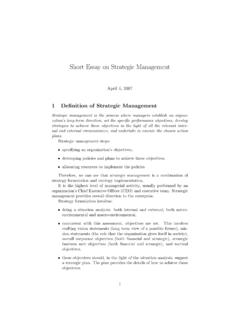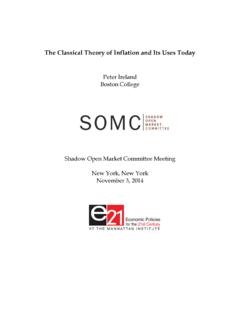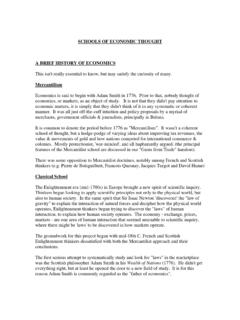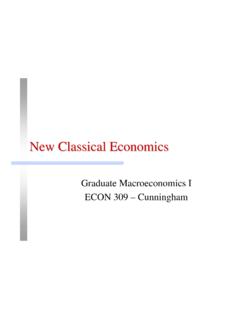Transcription of CLASSICAL THEORIES OF INTERNATIONAL TRADE
1 INTERNATIONAL economics, Course 2. CLASSICAL THEORIES OF INTERNATIONAL TRADE . INTERNATIONAL economics, Course 2. 1. Mercantilism (William Petty, Thomas Mun and Antoine de Montchr tien model). 2. The Absolute Advantage (Adam Smith model). 3. The Comparative Advantage (David Ricardo model). 1. Mercantilism (William Petty, Thomas Mun and Antoine de Montchr tien model). Mercantilism is a philosophy from about 300 years ago. The base of this theory was the commercial revolution , the transition from local economies to national economies, from feudalism to capitalism, from a rudimentary TRADE to a larger INTERNATIONAL TRADE . Mercantilism was the economic system of the major trading nations during the 16th, 17th, and 18th century, based on the premise that national wealth and power were best served by increasing exports and collecting precious metals in return.
2 It superseded the medieval feudal organization in Western Europe, especially in Holland, France, United Kingdom, Belgium, Portugal and Spain. The monarch controlled everything. Their policy was to export in the countries that they controlled and not to import (to have a positive Balance of TRADE ). Geographical discoveries not only stimulated the INTERNATIONAL TRADE , but also produced an affluent flow of gold and silver, which could be used to encourage the economy based on money and prices. The state exercised much control over economic life, chiefly through corporations and trading companies. Production was carefully regulated with the object of securing goods of high quality and low cost, thus enabling the nation to hold its place in foreign markets. The theory states that the world only contained a fixed amount of wealth and that to increase a country wealth; one country had to take some wealth from another, either through having a higher import/export ratio.
3 So, this tendency, to export more and import less and to receive in exchange gold (the deficit is paid in gold) is called MERCANTILISM. The theory was criticized by the newly appeared class. More money was associated with less products and inflation. The standard of living is weaker. Mercantilist ideas did not decline until the coming of the Industrial Revolution and of laissez-faire. INTERNATIONAL economics, Course 2. 2. The Absolute Advantage (Adam Smith model). In the second half of the XVIII century, mercantilist policies became an obstacle for the economic progress. Adam Smith (father of liberalism and economical science) brought the argument in his book The Wealth of Nations , published in 1776, that the mercantilist policies favorised producers and disadvantaged the interests of consumers. Adam Smith's theory starts with the idea that export is profitable if you can import goods that could satisfy better the necessities of consumers instead of producing them on the internal market.
4 The essence of Adam Smith theory is that the rule that leads the exchanges from any market, internal or external, is to determine the value of goods by measuring the labour incorporated in them. In order to demonstrate its theory, Adam Smith analyzed for the beginning country A, using one factor of production, the productivity of labour, evaluated in the necessary of hours needed to produce a unit of measure of the products X and Y. He used a unifactorial system of economy. Symbolizing H-hours, L-labour, the unitary necessary of labour for product X is HLX and for Y HLY. Because all the economies have limited resources, there are limits in the level of production, and if a country wants to produce much of one product it has to give up producing another goods, existing in this case renounce of TRADE . Renounces can be illustrated by a graphic.
5 THE PRODUCTION POSSIBILITY FRONTIER. INTERNATIONAL economics, Course 2. We have a single factor of production- labour, which results in productivity. This country has a resource of labour of 8+4=12 hours. - with 4 hours of labour the country can produce 1 kilo of cheese - with 8 hours of labour the country can produce 1 liter of wine The production possibility frontier illustrates the variety of the mixing of goods that can be produce by the economy. The opportunity cost is the number of measure units of product Y to which the economy has to give up in order to produce one supplementary unit of product X. SPECIALIZATION IN PRODUCTION AND THE ADVANTAGE FROM. TRADE THROUGH ABSOLUTE ADVANTAGE. PRODUCTS. units of product/units of time COUNTRY AFTER. WITHOUT TRADE SPECIALIZATION. AND TRADE . X Y X Y. A 6 3 12 - B 3 6 - 12.
6 TOTAL 9 9 12 12. Country A is more productive then B in the production of X and it has an absolute advantage in this product and country B is more productive then B in producing product Y. It is reasonable and in the benefit of 2 countries to concentrate all resources of labour to the product for which they have absolute advantage. After specialization, exchanging products, both countries gain from TRADE . 3. The Comparative Advantage (David Ricardo model). David Ricardo theory demonstrates that countries can gain from TRADE even if one of them is less productive then another to all goods that it produce. Comparative Advantage from TRADE with 2 products INTERNATIONAL economics, Course 2. PRODUCTIVITY. Opportunity cost COUNTRY hours/monetary units X Y X Y. A 1 2 B 6 3 Country A is more productive in X than in Y. Country B is more productive in Y than in X.
7 Each country should specialize in the production for which it has less opportunity cost.










